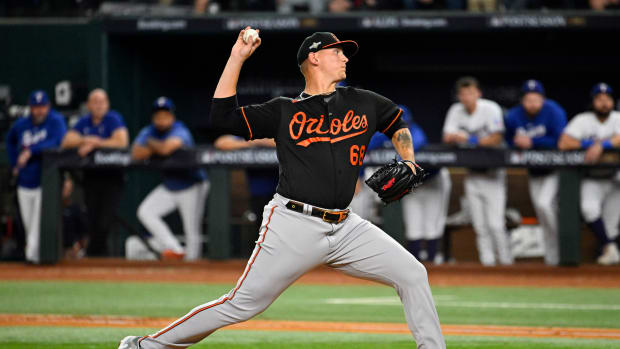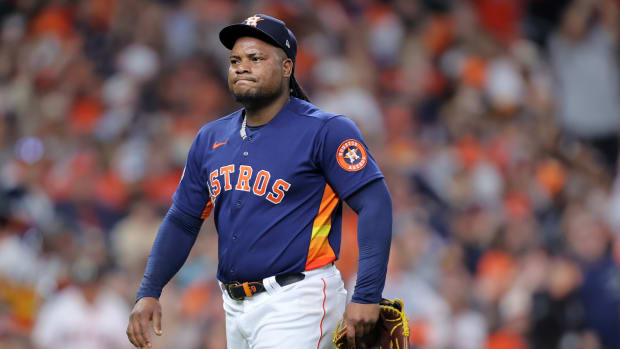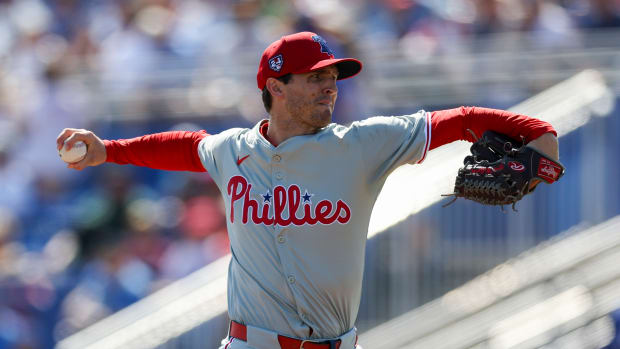For Phillies ace Cliff Lee, elbow injury could spell end of stellar career
The news has not been good for Cliff Lee this week. The 36-year-old lefty, who was limited to 13 starts last year due to a strained flexor tendon, still has a tear in his elbow, according to a diagnosis by Dr. James Andrews. While he was cleared to resume his throwing program, he is still experiencing discomfort and faces the possibility of surgery that would not only end his season but also perhaps his career.
Preaching patience for talented Cubs trio of Soler, Baez and Bryant
Lee first went on the disabled list with the injury in his left elbow last May 19. He returned two months later but made just three more starts, allowing nine runs in 13 1/3 innings before returning to the DL for the remainder of the season. Both he and the Phillies had hopes that he could rehabilitate the injury without surgery, but in the wake of his first spring start on March 5—a 22-pitch effort in which he worked in the 87-88 mph range, a few clicks below his typical velocity—he experienced renewed discomfort. An exam by team physician Dr. Michael Ciccotti revealed "very mild" inflammation, but a follow-up by Dr. Andrews confirmed that he still has the tear, with Phillies head athletic trainer Scott Sheridan telling reporters that the injury "looks exactly the same as what it did last year."
In the wake of that sobering diagnosis, Lee said, "I'm not going to go out there in pain to where something bad could potentially happen…. That doesn't make sense to me. I'm going to play as long as I comfortably can. When it's uncomfortable to play and it hurts to play, then it's not worth it."
• JAFFE: How Stroman's injury affects Blue Jays' contender hopes
Now in the final year of a five-year, $120 million deal he signed with the Phillies in December 2010, Lee is making $25 million, with a $27.5 million club option and a $12.5 million buyout for '16. The option would vest if he reaches 200 innings and doesn't end this season on the disabled list. Not only does that appear unlikely, but it also sounds as though he might pack it entirely if he needs surgery. Via ESPN's Jayson Stark:
Although Lee talked about surgery, he said it's possible that, given his age, he might choose to retire instead.
"Yeah, I've got to factor all those things in," he said. "I've got a family at home and I've been away from them for a long time, so that is part of the equation. If I were to have the surgery, am I going to go through all that to try to pitch again, or am I going to shut it down? That's a decision that I'll have to make once that time comes, if that times comes."
Lee threw his first bullpen session since the diagnosis on Wednesday morning, after which he didn't sound particularly encouraged. Via MLB.com's Todd Zolecki, he said, "I got through it. There's still something there. Same as yesterday.… If it starts to progress worse, then obviously that's a pretty telling sign. If it maintains how it is, then I'll keep going."
As NL hoards top starters, game must change—but not by adding DH
Hopefully, we haven't seen the last of Lee in a competitive situation, because he's been one of the game's elite pitchers in the latter half of a 13-season career in which he's accumulated a 143-91 record and 3.52 ERA and earned All-Star honors four times. A fourth-round draft choice by the Expos out of the University of Arkansas in 2000, Lee was traded to the Indians in the Bartolo Colon blockbuster in June 2002, a heist that also brought Grady Sizemore and Brandon Phillips at a time when the Expos were wards of the other 29 teams. He made his major league debut in September of that year but didn't stick in the Indians' rotation until '04; he had a strong season in '05 but as late as '07 needed a return to the minors and was left off the team's postseason roster.
Through the 2007 season, Lee put up a 4.64 ERA (94 ERA+) and a grand total of 5.0 WAR across 125 starts and four relief appearances. But thanks to massive improvements in his control and command, he broke out in a big way in '08, going 22-3 with league bests in wins, ERA (2.54), home run and walk rates (0.5 and 1.4 per nine, respectively) and WAR (6.9) en route to the AL Cy Young award. In doing so, he became the first pitcher ever to go from a 6.00 ERA in at least 50 innings in one season to an ERA below 3.00 in over 200 innings the following season.
Has the time come for the National League to adopt the DH?
From 2008 to '13, Lee was the majors' most valuable pitcher, with his 37.4 WAR outdistancing second-ranked Justin Verlander's 32.6, and his 2.89 ERA and 140 ERA+ bested only by Clayton Kershaw's 2.60 among pitchers with at least 500 innings. He has posted the league's lowest walk rate and highest strikeout-to-walk ratio three times apiece since then, putting forth the majors' best marks in both categories as well during that span (1.33 and 6.1, respectively).
Lee was traded three times during that run: from the Indians to the Phillies on July 29, 2009, from the Phillies to the Mariners on Dec. 16 of that same year, and from the Mariners to the Rangers on July 9, 2010. While bouncing around, he helped the Phillies and Rangers to the World Series, and through his first eight postseason starts, he totaled five games with double-digit strikeout totals—walking exactly one batter in those games—and three complete games, though he was roughed up in two of his four World Series starts and his teams wound up on the short end of those championships.
• JAFFE: Cuban free agent Hector Olivera surrounded in mystery
While the Yankees and the Rangers both pursued Lee heavily once he reached free agency after the 2010 season, the Phillies swooped in as the mystery team to re-sign him. In his first three years under that deal, Lee made at least 30 starts and threw at least 211 innings in each season, totaling 20.4 WAR, but since helping the team to its fifth straight postseason appearance in '11, the injuries and age-related declines of other key Phillies—Roy Halladay, Ryan Howard and Chase Utley in particular—have led to an absence from the postseason that's at three years and counting.
Denard Span, Jayson Werth injuries expose Nationals' lineup vulnerability
Having finally embarked on a much-needed rebuilding program after their second straight 73-win season and their first last place finish since 2000, the team held out hope that Lee could demonstrate a return to health and thus become a trade target. That said, the recency of his injury, his massive option and his partial no-trade clause (with the ability to block deals to 20 teams) would have been complicating factors in any deal, to say nothing of general manager Ruben Amaro's reputation for making exorbitant demands in return for his highest-paid players, a factor that has slowed an already-overdue turnover. Having traded Shane Victorino in '12 and Jimmy Rollins last December, Amaro has explored dealing Cole Hamels, but his unwillingness to eat salary while cleaning out his potential trade partners' farm systems has prevented the ace lefty from being dealt thus far. Lee wouldn't fetch the same return as Hamels, but any usable pieces would have made more sense than the minimum of $37.5 million the team will wind up paying him.
If Lee is out, the Phillies' rotation is likely to include Hamels (barring a trade, of course), Aaron Harang, David Buchanan and Jerome Williams, with Miguel Alfredo Gonzalez and Sean O'Sullivan among the candidates for the fifth spot. Chad Billingsley, who has made just two major league appearances since Aug. 24, 2012, could join the team in late April if his own rehab from a flexor tendon strain—which he suffered while rehabbing from April 2013 Tommy John surgery—remains on track.
That’s not a rotation that's likely to contend, but even with Lee, the team would appear to be a long-shot for a playoff spot, even in a division where the Braves have embarked upon rebuilding and the Mets have continued to skimp on upgrades to go with their cadre of young pitchers. Without him, the Phillies’ 2015 season is likely to be that much more forgettable.


































